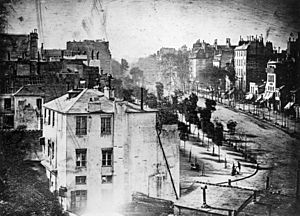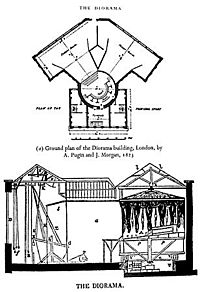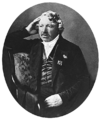Louis Daguerre facts for kids
Quick facts for kids
Louis Daguerre
|
|
|---|---|

Daguerre around 1844
|
|
| Born |
Louis-Jacques-Mandé Daguerre
18 November 1787 Cormeilles-en-Parisis, France
|
| Died | 10 July 1851 (aged 63) Bry-sur-Marne, France
|
| Known for | Invention of the daguerreotype process |
| Spouse(s) | Louise Georgina Arrow-Smith (married 1810–1851) |
| Signature | |
 |
|
Louis-Jacques-Mandé Daguerre (born November 18, 1787 – died July 10, 1851) was a French artist and inventor. He is famous for creating the daguerreotype, an early type of photography. Because of his work, he is known as one of the "fathers of photography." Besides photography, Daguerre was also a talented painter and designed amazing theatre shows. He even invented a special kind of theatre called the diorama.
Contents
Louis Daguerre: Photography Pioneer
Early Life and Art
Louis Daguerre was born in a town called Cormeilles-en-Parisis, France. When he was young, he learned about architecture and theatre design. He also studied painting, especially large, circular paintings called panoramas.
Daguerre was very good at creating illusions for the stage. He became a well-known designer for theatres. Later, he invented the diorama, which was a new kind of theatre experience. His first diorama opened in Paris in July 1822.
Inventing the Daguerreotype
In 1829, Daguerre teamed up with Nicéphore Niépce. Niépce was another inventor who had made the world's first permanent photograph in 1826 or 1827. Sadly, Niépce died suddenly in 1833.
Daguerre kept working on their ideas. He improved the process, which later became known as the daguerreotype. In 1839, he shared his invention with the public. The French government bought his invention. They then gave it as a gift to the world, making the instructions free for everyone.
How the Daguerreotype Worked
Before Daguerre, Niépce used a sticky substance called bitumen to make photos. This process needed many hours of light exposure. After Niépce's death, Daguerre focused on how silver reacts to light.
For the daguerreotype, he used a thin sheet of copper coated with silver. He exposed this plate to iodine vapor, which created a light-sensitive layer. Then, he put the plate in a camera. At first, this also needed long exposure times.
But Daguerre made a big discovery! He found that even a very faint, invisible image (called a "latent" image) could be made visible. He did this by exposing the plate to mercury vapor. When he first saw an image appear, he famously said, "I have seized the light – I have arrested its flight!"
First Photos and Challenges

After developing the image, Daguerre had to "fix" it. This meant making it permanent so light wouldn't ruin it. He used salt water, and later, a chemical called "hypo" (sodium thiosulfate).
The finished daguerreotype was a very detailed image on a shiny silver surface. It was like a mirror. To see it best, you had to hold it at a certain angle. The surface was very delicate. So, daguerreotypes were almost always sealed under glass to protect them.
Early daguerreotypes needed long exposure times, sometimes ten minutes or more. This made taking portraits difficult because people had to stay perfectly still. Samuel Morse, another inventor, noticed that photos of Paris streets didn't show people or vehicles. He realized this was because anything moving disappeared during the long exposure.
Over time, new chemicals and better lenses made exposures much faster, sometimes just a few seconds.
The daguerreotype was unique; you couldn't easily make copies. Later, other photo processes like the calotype and wet collodion process allowed for many copies to be made. These new methods were also cheaper and easier to view. By the 1860s, most photographers had stopped using Daguerre's process.
The Amazing Diorama Theatres
In 1821, Daguerre teamed up with Charles Marie Bouton to create a diorama theatre. Daguerre was great with lights and stage effects.
The first diorama theatre opened in Paris in 1822. It showed two large paintings at a time. One was usually by Daguerre, and the other by Bouton. One painting would be an indoor scene, and the other a landscape.
What Was a Diorama?
Dioramas were huge. A large, see-through canvas, about 70 feet wide and 45 feet tall, was painted on both sides. These paintings were very detailed. Lights shone on them from different angles. As the lights changed, the scene would magically transform. The audience would slowly see the painting on the other side of the screen. This effect was truly amazing.
Because the paintings were so big, they stayed still. Instead, the audience sat in a round room that slowly turned from one scene to the next. About 350 people could watch each show.
Daguerre's dioramas were very popular and made a lot of money. New diorama theatres opened in London and Berlin. However, in 1839, a fire destroyed the Paris theatre. Daguerre was more worried about his daguerreotype notes and equipment, which were saved.
Later, people became more interested in motion photography and cinema. This, along with the fire, led to the end of the diorama's popularity.
Daguerre's Legacy
Louis Daguerre died on July 10, 1851, near Paris. A monument marks his grave. His name is also one of the 72 names carved on the Eiffel Tower in Paris, honoring his important contributions to science and art.
Portraits of and artworks by Louis Daguerre
See also
 In Spanish: Louis Daguerre para niños
In Spanish: Louis Daguerre para niños
- John Herschel
- Frederick Langenheim
- List of people considered father or mother of a field
- Photographic processes
- Daguerreotype








